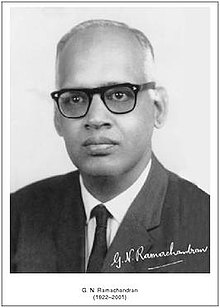Gopalasamudram Narayana Iyer Ramachandran
| G.N. Ramachandran | |
|---|---|

G.N. Ramachandran (8 October 1922-7 April 2001)
|
|
| Born |
8 October 1922 Ernakulam, Kerala, British India |
| Died | 7 April 2001 (aged 78) Chennai, Tamil Nadu, India |
| Nationality | Indian |
| Fields | Biophysics |
| Institutions |
St. Joseph's College, Tiruchirappalli Madras University Indian Institute of Science Cavendish Laboratory |
| Alma mater |
Madras University University of Cambridge |
| Doctoral advisor | C V Raman |
| Known for | Ramachandran plot |
Gopalasamudram Narayanan Ramachandran, or G.N. Ramachandran, FRS (8 October 1922 – 7 April 2001) was an Indian physicist who was known for his work that led to his creation of the Ramachandran plot for understanding peptide structure. He was the first to propose a triple-helical model for the structure of collagen. He subsequently went on to make other major contributions in biology and physics.
Ramachandran was born in the town of Ernakulam, Kerala, India to a Tamil speaking family. He completed his B.Sc honours in Physics from St. Joseph's College, Tiruchirappalli in 1939. He joined the Indian Institute of Science, Bangalore in 1942 in the Electrical Engineering Department. Quickly realizing his interest in physics, he switched to the Department of Physics to complete his master's and doctoral thesis under the supervision of Nobel laureate Sir C. V. Raman. In 1942, he received a master's degree in physics from Madras University with his thesis submitted from Bangalore (he did not attend any Madras college at that time). He subsequently received his D.Sc. degree in 1947. Here he mostly studied crystal physics and crystal optics. During his studies he created an X-ray focusing mirror for the X-ray microscope. The resulting field of crystal topography is used extensively in studies involving crystal growth and solid-state reactivity.
...
Wikipedia
